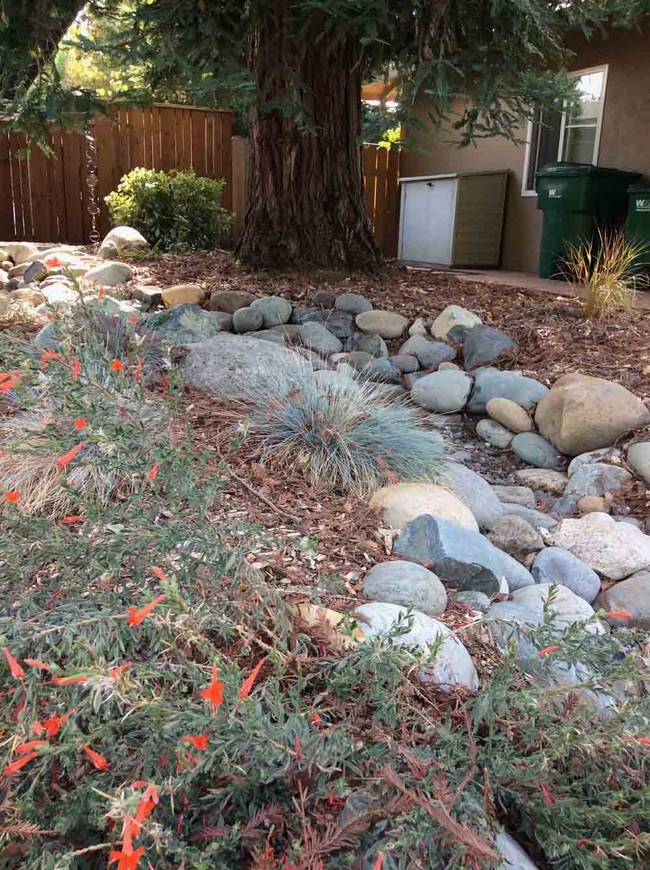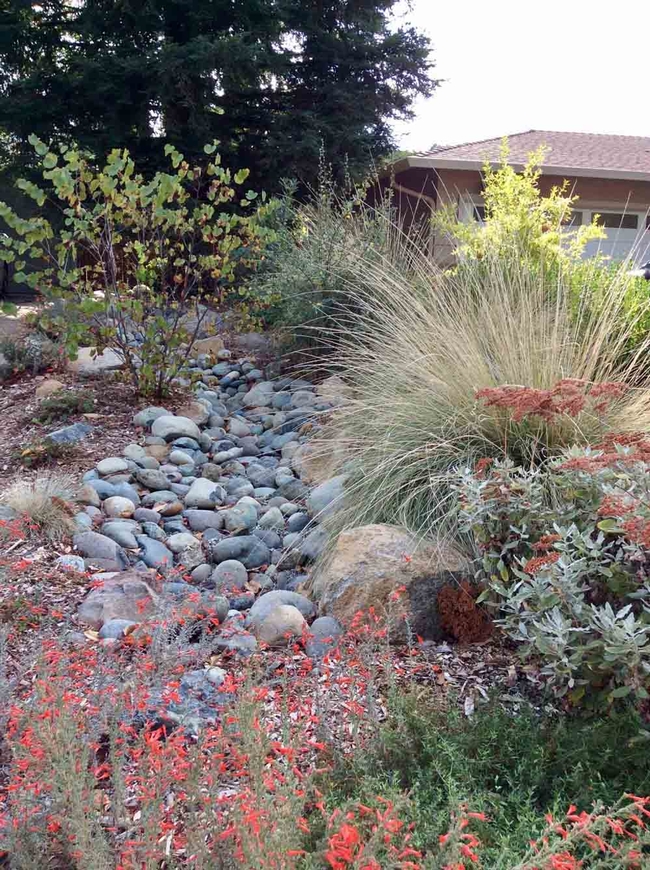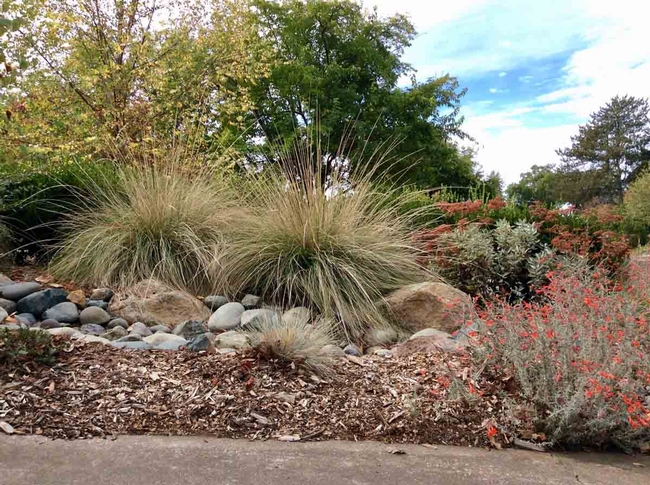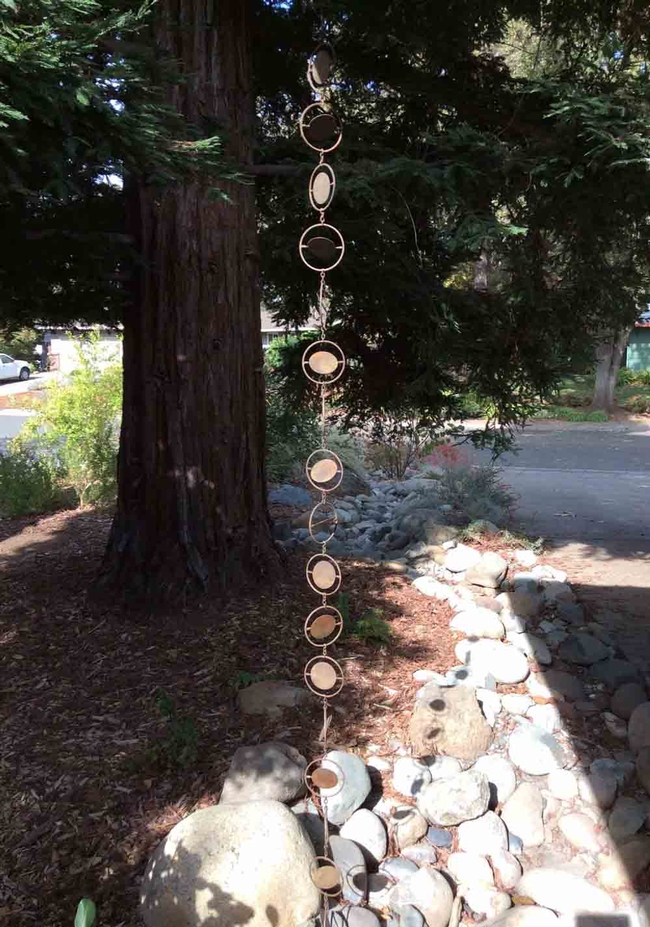Whew! At last we are getting some serious rain in the North State this season. We all agree that rainwater is precious—so why do we try so hard to move it off our property? On city and suburban lots, we channel rainwater from roof gutter downspout to street gutter storm drain as directly as possible. We don't want rainwater pooling around our foundations or settling into muddy sumps in our gardens, so modern houses and driveways are engineered to clear the runoff. But why not capture that precious rainwater in the soil? “Slow it, spread it, sink it” is the rallying cry of this permaculture principle of rain capture, and with some fairly simple landscaping—small berms, swales, and basins that direct, detain, and filter water—we can invigorate our soil ecology, enhance our yard's aesthetic and habitat value, filter pollutants, and help relieve over-tasked city storm drains.

The goal of on-site rain capture is to allow water to percolate into the soil rather than to create holding ponds, which require more complex engineering (and can foster mosquito breeding). Any effective rain garden landscaping should discourage standing water and allow flow to infiltrate the soil within a day or two. This can be as simple as a gravel-lined trench (often called a French drain) leading from a downspout to a grassy meadow or planting bed. A more complicated retention basin might entail layers of soil, gravel, and sand designed for slow seepage. For the purposes of this brief introduction, let's focus on a versatile and relatively simple structure, the swale.
A swale is a shallow channel, bermed a bit on both sides, that lets gravity do the work of moving rainwater along a gently sloping course. The swale directs water away from structures and through a straight or meandering depression lined with river rock, grasses, or other vegetation that can tolerate periods of winter wet and summer dry (regional native plants generally fit the bill). A grassy, vegetative swale might be lined with cool-season native meadow grasses such as sedges (Carex species) or rushes (Juncus species) that thrive with winter moisture and go dormant over the dry summer. A rock-lined swale resembling a dry creek bed holds visual interest throughout the seasons. Water-loving plants can be sited closer to the flow, while more water-averse selections can keep their feet dry further up the banks.

In general, your rainwater collection surface should slope downward from the water source, or you can create a minimum 2% slope. Steep slopes can create erosion, so avoid orienting your swale down slope in such areas.
Locate your swale:
- At least five feet away from structures without a basement, or ten feet from structures with a basement.
- Away from septic systems and leach fields
- Away from a tree's crown or major root zone to avoid root rot
- In full or partial sunlight to support plantings

Anchor your artificial creek bed with larger stones, boulders, and deep-rooted plants such as deer grass (Muhenbergia rigens) and fescues (Festuca species). If space permits, larger shrubs can create a more dramatically varied look. Vegetation should be planted and at least partly established before the winter storms, so be prepared to irrigate in dry periods and through at least the first summer. Once well established, deep-rooted native plants will enjoy the cool season storm water and survive the summer heat.
The illustrations here depict a professionally-designed creek bed along the driveway of a family home in Chico near lower Bidwell Park. A DIY project could be smaller in length, width, and overall scale while still employing some of the elements that make this feature so delightful.

From a simple gravel channel to a dry creek to a more elaborate retention pond, the hardscape elements of a rain garden project may seem daunting without step-by-step instruction. “Coastal California Rain Gardens” published by University of California Agriculture and Natural Resources (UCANR), offers detailed information about planning, building, and maintaining a rain garden, along with plant suggestions and resource listings.
UC Master Gardeners of Butte County are part of the University of California Cooperative Extension (UCCE) system. To learn more about us and our upcoming events, and for help with gardening in our area, visit our website. If you have a gardening question or problem, email the Hotline at mgbutte@ucanr.edu or leave a phone message on our Hotline at (530) 538-7201. To speak to a Master Gardener about a gardening issue, or to drop by the MG office during Hotline hours, see the most current information on our Ask Us Hotline webpage.
All photographs by Alicia Springer. Additional information and plant names used in photos:
Plants that tolerate winter moisture and summer drought line the banks of the swale. Idaho fescue (Festuca idahoensis) and California fuchsia (Epilobium canum) are seen. A redwood (Sequoia sempervirens) is on a raised bank so rainwater can irrigate but not saturate the root area. The redwood will require summer watering to stay healthy in the Butte County climate unless it's near a perennial stream.
A dry creek rain swale in a suburban garden landscape. The swale, roughly 50 feet long x 10 feet wide, runs along a sloping driveway. Redbud (Cercis occidentalis), deergrass (Muhlenbergia rigens), St. Catherine's Lace (a buckwheat, Eriogonum giganteum), Santa Barbara daisy (Erigeron karvinskianus) and California fuchsia (Epilobium canum) are among the native species seen.
Boulders and deergrass (Muhlenbergia rigens) stabilize the slope and provide pleasing visual variety. Larger native plant selections screen the property. These include toyon (Heteromeles arbutifolia), mountain mahogany (Cercocarpus betuloides), deer grass, and redbud (Cercis occidentalis).
A decorative rain chain at the ‘headwaters' of the creek bed directs flow from the roof gutter. Note that the creek bed is directed away from the base of the redwood, which is on a higher bank.